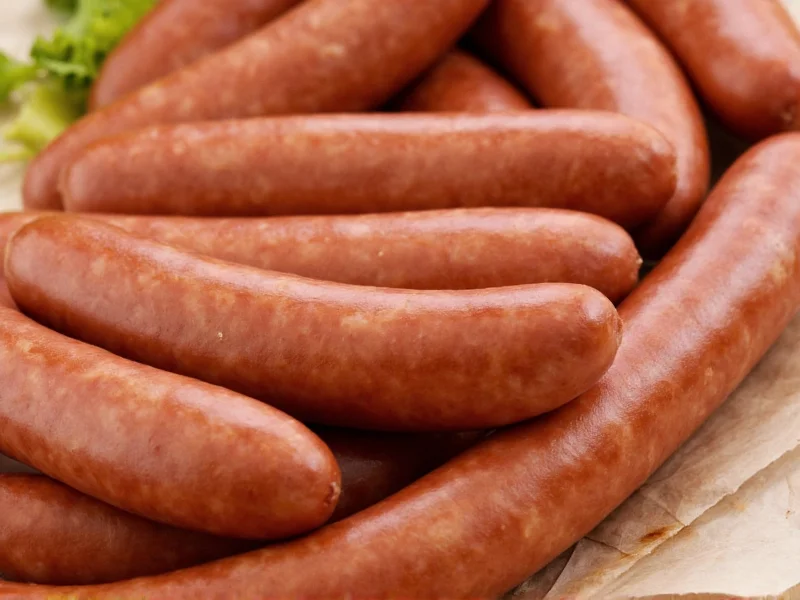Sausages represent one of humanity's oldest food preservation techniques, dating back to ancient civilizations. This versatile food product has evolved across cultures while maintaining its fundamental definition: a seasoned meat mixture encased for cooking or preservation. Understanding the sausage definition requires examining its essential components, historical development, and global variations that have emerged over centuries.
Essential Components of Sausage
Every authentic sausage contains four fundamental elements that distinguish it from other meat preparations. The meat component typically constitutes 60-80% of the mixture, with pork being most common globally, though regional preferences vary significantly. Fat content (usually 20-30%) provides moisture and flavor during cooking. Seasonings and binders create distinctive regional profiles, while the casing—whether natural or artificial—gives sausage its characteristic shape and texture.
Historical Development of Sausage Making
The practice of sausage making originated as a practical solution for meat preservation before refrigeration. Ancient Mesopotamians created sausage-like products around 3000 BCE, using animal intestines as natural casings. Roman soldiers carried sausages on campaigns as portable protein sources. By the Middle Ages, European butchers had developed regional specialties that evolved into today's beloved varieties. The word "sausage" itself derives from the Latin "salsus," meaning "salted," highlighting preservation's central role in sausage definition.
Global Sausage Varieties Compared
| Region | Signature Sausage | Distinctive Ingredients | Preparation Method |
|---|---|---|---|
| Germany | Bratwurst | Pork, marjoram, caraway | Grilled or pan-fried |
| Spain | Chorizo | Pork, smoked paprika, garlic | Dry-cured or fresh |
| Italy | Mortadella | Pork, pistachios, black pepper | Emulsified, cooked |
| Mexico | Longaniza | Pork, vinegar, ancho chili | Fresh or semi-cured |
| United States | Breakfast Sausage | Pork, sage, black pepper | Fresh, pan-fried |
Modern Sausage Production Techniques
Contemporary sausage making combines traditional methods with modern food science. Commercial producers use precise grinding equipment to achieve consistent texture, while artisanal makers often prefer hand-mincing for superior mouthfeel. Temperature control during mixing prevents fat smearing, crucial for proper texture development. Many traditional sausages now incorporate food safety protocols like controlled fermentation and precise curing salt measurements, maintaining authentic flavors while meeting modern safety standards. Understanding what constitutes a proper sausage definition requires recognizing these production nuances that distinguish quality products.
Dietary Adaptations and Alternatives
Modern dietary preferences have expanded traditional sausage definition to include numerous adaptations. Vegetarian sausages typically use textured vegetable protein, mushrooms, or legumes as base ingredients, while vegan versions eliminate all animal products. Gluten-free options substitute traditional binders with alternatives like rice flour. Low-sodium varieties address health concerns without sacrificing flavor through innovative seasoning blends. These adaptations demonstrate sausage's remarkable versatility while maintaining the essential form and function that define this food category.
Cultural Significance of Sausages Worldwide
Sausages serve as culinary ambassadors of regional identity, often featuring prominently in national celebrations and daily cuisine. Germany's Oktoberfest wouldn't be complete without bratwurst, while Spain's chorizo appears in countless traditional dishes. In the American South, pork sausage forms the backbone of breakfast traditions. Each culture's approach to sausage making reflects local agricultural practices, historical influences, and flavor preferences, making the study of sausage definition a window into broader cultural narratives. This global perspective helps answer the question: what is sausage beyond its basic components?
What is the basic definition of sausage?
A sausage is fundamentally defined as ground meat mixed with seasonings and stuffed into a casing. The essential components include meat (typically pork, beef, or poultry), fat, salt, and flavorings, with the casing serving as the container that gives sausage its characteristic shape during cooking or preservation.
Are all sausages made with pork?
No, while pork is the most common meat used in sausages globally, many varieties use beef, poultry, lamb, or even game meats. Religious dietary restrictions have produced numerous alternatives, such as halal beef sausages or kosher turkey sausages. The essential sausage definition focuses on the preparation method rather than the specific meat type.
What makes a sausage different from ground meat?
The key differences lie in seasoning, texture, and preparation. Sausages contain specific spice blends and salt levels that enhance flavor and aid preservation. The grinding process for sausages typically creates a finer, more emulsified texture than standard ground meat. Most importantly, sausages are stuffed into casings, which affects how they cook and their final texture, distinguishing them from loose ground meat products.
Can sausages be considered healthy food options?
The nutritional profile varies significantly by type. Traditional sausages can be high in fat and sodium, but many modern varieties offer leaner options with reduced sodium. Some specialty sausages incorporate vegetables, whole grains, or alternative proteins to improve nutritional value. When consumed in moderation as part of a balanced diet, certain sausage varieties can contribute to a healthy eating pattern while providing essential nutrients like protein and B vitamins.
How has the definition of sausage evolved over time?
While the core concept remains consistent—seasoned meat in a casing—the definition has expanded to include numerous variations. Historically focused on meat preservation, modern sausage definition now encompasses fresh cooking varieties, dried cured products, and even plant-based alternatives. Technological advances in food safety and processing have broadened acceptable production methods while maintaining the essential characteristics that define this versatile food product.











 浙公网安备
33010002000092号
浙公网安备
33010002000092号 浙B2-20120091-4
浙B2-20120091-4